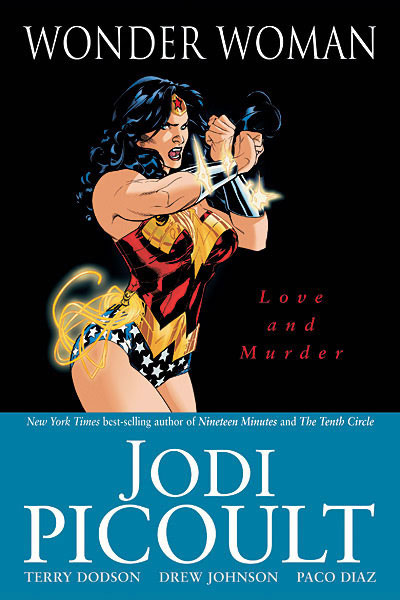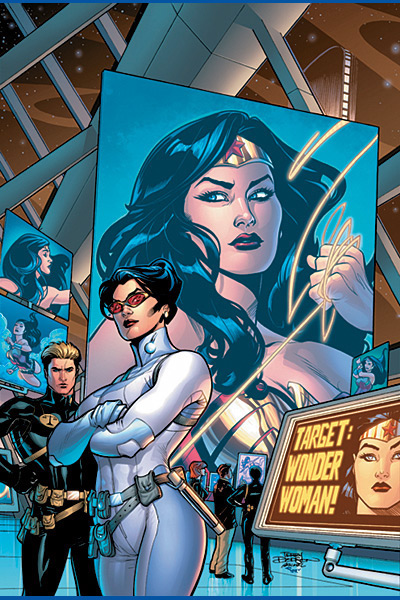
In her first graphic novel (DC Comics, 2007), Jodi Picoult takes Wonder Woman on a collision course with her long-missing people, the Amazons. The action begins when Wonder Woman is assigned the task of capturing Wonder Woman while in her disguise as Special Agent Diana Prince of the Department of Metahuman Affairs. How will she be able to accomplish the impossible task of capturing herself without revealing her secret identity? This is just the start of the Amazon Warrior's problems, as Diana must relearn how to exist as a human woman while a deadly foe begins closing a net on her that will lead to a catastrophic outcome! Read Jodi’s take on the most famous female superhero!
There are some who might describe Picoult as a real-life “wonder woman,” balancing a career as a writer with her responsibilities as a wife and mother of three.
— She disagrees:
You can be the strongest woman in the world, and be incredibly sure of yourself in many realms of your life, and yet there’s always going to be a chink in your armor,” she observes. “There’s always going to be one part of your life that you wonder, ‘Am I doing a good enough job?’
When DC Comics approached me to write several issues of the Wonder Woman comic book series, my first order of business was to get that poor girl a functional outfit. After all, any woman who is even marginally as well-endowed as Wonder Woman knows you can’t fight crime – much less go about more mundane daily activities – while you’re worried about your top falling off. I had visions of her off-panel, tugging up that glittery spandex corset. Could we just add some straps to her bustier? I asked, and I was politely told that the costume had been around for sixty-odd years for good reason.
It begged the question though: why has Wonder Woman had such staying power? And for that matter, who’s reading her? She has long been upheld as a role model for young girls – the epitome of a strong female icon – but her sheer bodaciousness (and that costume) suggests that it’s her body, not her face, that’s attracting male readers. The paradox began back in 1941, when she was created by William Moulton Marston – the psychologist who’d invented the polygraph. He believed that women were more honest than men, and were better workers – and he had a vision of the future in which women ruled over men. As if this wasn’t revolutionary enough for the 1940s, he and his wife Elizabeth lived with another woman, Olive Byrne, in a polyamorous relationship. His Wonder Woman was an amalgamation of the women in his life – free-spirited, unconventional, and strong. Known as Princess Diana to the Amazons with whom she grew up, Wonder Woman sported indestructible bracelets – a gift from Athena, and a lasso of truth – an Olympian deity’s equivalent of Marston’s polygraph. She was six feet tall, stunning, packed a mean punch – and slipped neatly into the Golden Age of Comic Books, when DC was powered by a testosterone triumverate: Batman, Green Lantern, and Superman.
Believe it or not, girls used to read more comics than boys. In the early 1940s the Archie Comics and others like them offered three female role models: career girls who became nurses or secretaries; swooning heroines who got married and had happily-ever-afters; or bubble-gum teens, like Betty and Veronica, who had catfights over Archie. Wonder Woman blew these stereotypes away. She was strong enough to kick Superman’s ass, didn’t need a guy to be happy, and had a job track that, in one of Marston’s stories, took her right into the Oval Office as President of the United States. And yet, even as Wonder Woman battled the Nazis and crime, there were episodes of bondage that were, at best, cringe-worthy and at worst, the stuff of Marston’s sexual fantasies. She became the first female member of the Justice League of America – but she was relegated to the role of secretary.
And that, really, is the paradox of Wonder Woman. As she’s evolved, it’s always been one step forward, two steps back. Why? Well, I have a theory. For sixty years, the adventures of the world’s most recognizable superheroine have been written by men. With the exception of a three-issue run by Mindy Newell in the 1980s, I was the first woman approached to write the Wonder Woman comic book series. Granted, some of the story lines created by the men were fantastic – but they also involved stripping Wonder Woman of her powers, dumbing her down to run a boutique, leaving her blind and bound. What’s the point of having the world’s strongest female superhero, if you’re always trying to break her? It may have less to do with Wonder Woman herself than her male readers. When confronted by a strong, smart, beautiful women, most guys are entranced…and a little bit terrified. It’s one thing to say women are equal to men…it’s another to suggest that women are superior. This is why Wonder Woman can’t catch a break, even though she technically qualifies for a senior citizen ticket at the movies. She’s allowed to be strong. She just can’t be too strong – because then she alienates female readers, who find her too tough to identify with; and male readers, who find her too threatening to lust after.
Because she’s walking such a fine line, Wonder Woman has always struggled to find an audience. Not surprisingly, she has a huge gay and lesbian following. Like her buddies Batman and Superman, whose male readers want to be them, Wonder Woman has always had female fans who admire her strength and her intelligence. But she has male readers too, who admire – well – her breasts. As a writer, was there a way to keep both groups satisfied? I thought the answer, ironically, involved making Wonder Woman a little more like the rest of us. She’d still have all her superhuman powers – and her curves. But I didn’t want to humiliate her – the least I could do, as a fellow female. In my story line, Wonder Woman was smarter than everyone else. She was the one who rescued the dude in distress. And I played up elements of her life that allowed female readers to relate to her in a visceral way they never had. Unlike Superman, who has a back story in the real world (Clark Kent), Diana has always been an outsider. She loves humans, but she’s never going to be one of them. Just like today’s “wonder women”, she has to do it all – balance work, family, and self – while secretly wondering every now and then, Am I doing a good enough job? In other words, Wonder Woman was vulnerable – not physically, like in those creepy earlier incarnations of bondage – but mentally, with doubts that seemed real, honest, and awfully human. Suddenly, Wonder Woman had enough of a chink in her armor to make a male reader feel like he was on equal terms. And for female readers, Wonder Woman’s crisis of faith made her more than a sex symbol populating the fantasies of men. She was a sister; she was struggling; she was one of us.
I’m happy to say that I think Wonder Woman is headed in the right direction. In her current incarnation, she remains strong enough to go mano-a-mano with Superman, and she has incredible stamina. She’s got experience fighting crime, political oppression, and sheer sorcery. She can communicate with all sorts of animals and has staggering wisdom. She’s a flawless diplomat, leader, and warrior. And of course she still has that lasso of truth, to keep the rest of us honest. In fact, she sounds so much like real women I know that it’s tempting to wonder whether life’s imitating art, or vice versa. And while having a Wonder Woman in the White House temporarily remains the stuff of legend, I’m delighted that for the first time ever, DC Comics has assigned a female writer to the series for the long-term – the incredibly talented Gail Simone. Given that Ms. Simone was the impetus behind a website called Women in Refrigerators – a list of the gratuitous deaths of female characters in comic books, usually as a plot device for the male characters – I think Wonder Woman’s in very good hands.
As long as little girls dress up in those red boots and a tiara for Halloween; as long as we all hope for good to triumph over evil, there’s always going to be a place for Wonder Woman. Whether you admire her because she can kick through a brick wall without messing up her hair, or because she can (literally) fly circles around the guys, she represents what we all know: absolutely nothing can stand in the way of a strong woman.
In the last issue I wrote for DC Comics, I wrote myself into the script, instructing the illustrator to make an Amazon warrior look like a certain red-haired novelist moonlighting as a comic book writer. And sure enough, when the issue hit the stands, there was my alter ego…systematically beating the crap out of Batman.
Just for the record: the breastplate of my armor had straps.
